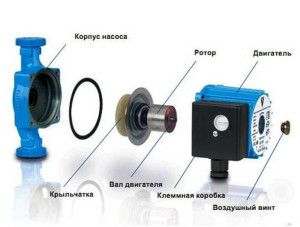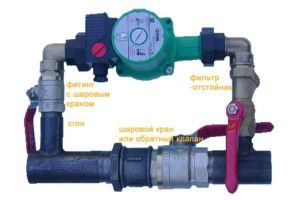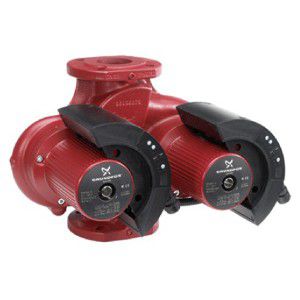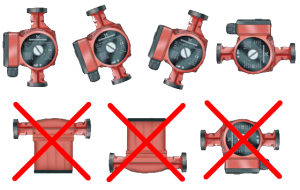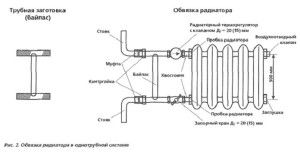Can I install the heating components myself? Despite the apparent complexity, this work can be done with your own hands without the help of specialists. It is important to know how to properly install the heating elements: battery, radiator, pump.
How to put a pump in the heating system
The circulation pump is designed to increase the speed of the coolant in a closed or open heating system. Often the thermal expansion of hot water is not enough for a normal rate. And then installation of additional equipment is necessary.
Before you put the pump into the heating system, you should choose the right model. To do this, you must first calculate the optimal characteristics of the system. Based on the data obtained, choose a model according to the following parameters:
- Productivity - m³ / h. Since it is possible to put the pump on heating only after calculating the amount of coolant in the system, this characteristic is decisive.
- Height of rise of water - m. Indicates what hydraulic resistance the pump can overcome during its operation.
Most often, the choice is simple models with a capacity of 2.2 to 3 m ³ / h and a height of water up to 4.5 m.
Another parameter is the diameter of the threaded connection for connecting the pump to the system. It should be equal to the size of the inlet pipes.
Choosing a pump installation location
The location of the equipment in the heating circuit depends on the type of heat supply, as well as the piping layout. But how to put the pump in the heating system in order to ensure operation during a power outage? To do this, mount a special pump unit.
In the event of a power outage, a stopped impeller will create additional resistance to water. Therefore, the coolant flow is routed through the bypass. Previously, using shut-off valves, the section with the pump is disconnected from the general circuit.
An important point is the installation site of the equipment in the circuit. The solution to the question of where to put the circulation pump in the heating system directly depends on the type of circuit:
- On the return pipe - for open and closed systems. You can install the pump on the feed, but at the same time, exposure to high temperatures will reduce its life.
- On each collector - for systems with combs. If the length of the individual circuits is large, it is necessary to put the pump in the heating system on each of them.
If several devices are installed, their operation will be synchronized. If this is not done, water hammering and uneven pressure in the pipelines may occur. To solve this issue, it is recommended to put the pump on a twin heating.
For normal operation of the equipment, installation is carried out only on straight sections of the highway. This is an optional condition, but many experts put the pump in the heating system in this way. This is explained by the absence of a pressure difference in these sections of the highway.
In a closed heating system, an expansion tank is installed in front of the circulation pump.
Connecting the pump to the system
After choosing the installation location, you can proceed directly to the installation. It is possible to put the circulation pump in the heating system only after the heat supply is completely turned off. Also in the pipes there should be no coolant or the installation site with the help of shut-off valves is cut off from the common pipeline.
To ensure safe operation, a filter must be present in the pump unit. After installing the pump in the heating system and starting the heat supply, debris may remain inside the pipes or scale may form. If it gets into the pump mechanism, the probability of its failure increases.
The basic rules for installing the pump on heating are as follows:
- The direction of movement of the coolant is taken into account. This is indicated by an arrow on the pump housing;
- For wet rotor models, installation is only horizontal. Otherwise, there is a high probability of air congestion entering the housing, which will lead to overheating of the engine;
- Correct installation of the pump in the heating system is to ensure the supply of electricity. The line must be grounded. In the event of a power outage, an emergency power supply is additionally mounted.
What is the best place to put the pump in open heating systems? The best option is on the return pipe to the boiler, described above. In some cases, installation on the supply line is allowed.
If antifreeze is planned to be poured into the system, the capacity of pumping equipment should be 15-20% higher than the calculated one. This is due to the higher density of this type of coolant.
How to put heating batteries
Radiators are designed to transfer thermal energy from the coolant to the room. In fact, they compensate for the heat loss in the building. Therefore, before installing a heating radiator, you must correctly select its location.
The best option is the place of greatest heat loss in a house or apartment - external walls and window structures. This should be foreseen at the stage of designing the heat supply. Then you should decide how to properly install the heating batteries and choose the connection method:
- Upper. It is used for vertical piping;
- Side. The method is suitable for horizontally located highways;
- Lower. The best option for flush mounting pipes.
The efficiency of the battery depends on the correct choice of this parameter. The figure below shows how to properly install a heating radiator regarding the method of connection to the system.
Another important point is the location of the heater relative to the walls and window structures. It is necessary to install a heating radiator so that it provides free air circulation. Almost all heat supply batteries operate on a converter basis. Those. air flows must pass through the maximum area of the devices. In order to correctly install heating batteries, you should adhere to such recommendations:
- The distance to the windowsill is at least 10 cm. At the same time, it should cover only 2/3 of the battery.
- The distance of the bottom of the radiator from the floor is 12 cm.
For proper installation of the heating radiator, you must first insulate the walls. You can increase the heat transfer rate using a reflective surface. Most often, penofol with a foil layer is used for this.
For mounting radiators, special mounting elements are used. Their design depends on the type of battery.
Harnessing radiators
Ensuring the normal operation of radiators is possible only with the correct strapping. Its elements must fulfill the functions of protection and regulate the degree of heating of the heater.
Correct installation of radiators depends on its type and design. Most often, manufacturers in the instructions indicate the optimal installation scheme. The following components are used to bundle the batteries:
- Mayevsky crane. Designed for timely removal of air jams;
- Temperature controller. It is necessary to regulate the volume of coolant inflow;
- Stop valves. With it, you can disconnect the radiator from the general heating system for further repair or replacement.
At the end of the installation, the tightness of all nodes is checked and the device is crimped.
During installation, it is not allowed to skew the radiator or the battery. This can lead to air congestion, as well as degrading the performance of the heating system.
The video shows how to install a heating radiator yourself.
